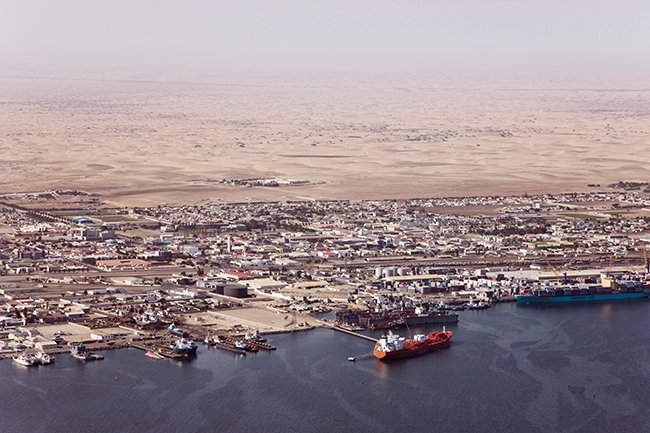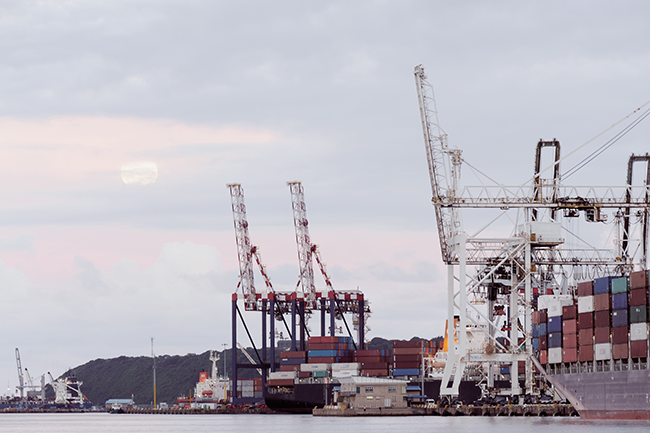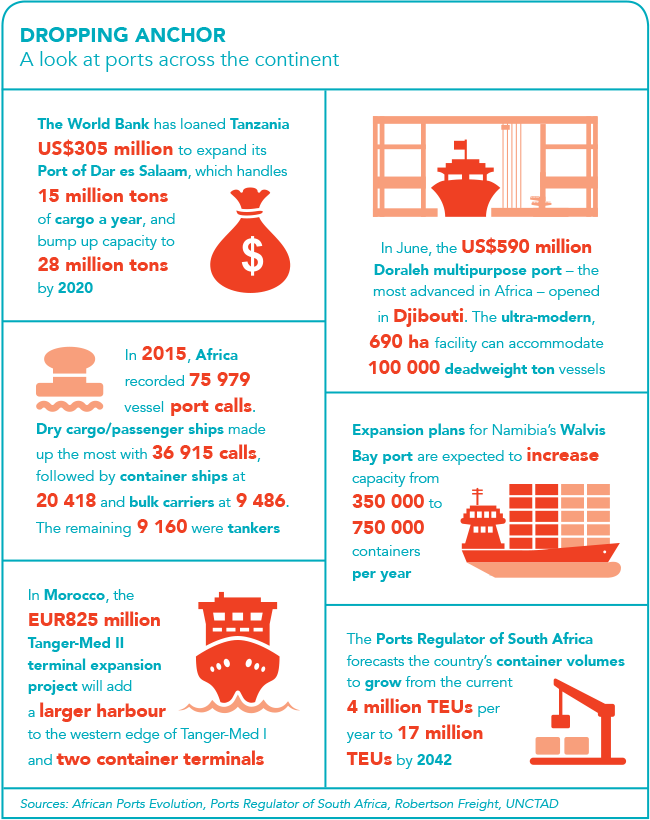According to the UN Conference on Trade and Development (UNCTAD) Review of Maritime Transport 2016, ‘maritime transport is the backbone of globalisation and lies at the heart of cross-border transport networks that support supply chains and enable international trade’. Not only does maritime transport enable industrial development but it also promotes regional economic and trade integration. In 2015, the estimated world seaborne trade volumes surpassed 10 billion tons for the first time. Around 80% of global trade by volume and more than 55% of global trade by value was seaborne, according to the report.
Some 90% of Africa’s imports and exports are conducted by sea. The African Development Bank (AfDB) has forecast that port throughput on the continent will increase from 265 million tons in 2009 to more than 2 billion tons in 2040.
Of the some 76 000 port calls around Africa recorded in 2015 by the UNCTAD Liner Shipping Connectivity Index, Egypt, Morocco and South Africa proved to be the busiest countries for maritime trade.
There are also significant levels of traffic in the Gulf of Guinea, Angola and Nigeria, according to Automatic Identification System data, with Angola, Egypt and Nigeria the largest ship-owning countries on the continent. Meanwhile, Southern Africa constitutes 41% of the continent’s container throughput.
Africa’s infrastructure investment needs per year through 2020 are estimated to exceed US$93 billion, according to the 2015 Bloomberg Brief. In 2013, Chinese President Xi Jinping launched the Belt and Road Initiative – a development strategy to link China to 60 countries across Asia, Africa and Europe along five trading routes by means of a maritime Silk Road. As part of the strategy, China will invest US$60 billion in African infrastructure projects – in partnership with the AU and other financial partners – such as airports, railways, highways, pipelines, ports and power grids, with key projects in Nigeria, Kenya, Ethiopia and Djibouti.
Walvis Bay Port – Namibia’s largest commercial and only major deepwater port, which handles 7 million tons of cargo annually – is undergoing a NAD4 billion upgrade as part of Namibia’s NDP to develop a logistics hub between Europe, the Americas and the landlocked SADC region, and further spearhead the country’s growing economy.
The project, which is contracted to China Harbour Engineering Company (CHEC), broke ground in May 2014 after a NAD3 billion loan from the AfDB. It’s set to be completed by 2019. The upgrades pertain to the North and South port sections and include a new container terminal, liquid bulk terminal, liquefied natural gas terminal and a multipurpose dry-bulk terminal. The project will increase the port’s container capacity to 750 000 TEUs (twenty-foot equivalent unit) annually. Meanwhile, a recreational waterfront, marina and cruise terminal are set to be completed at South port by 2022. It’ll be the first of its kind in Namibia and it is expected to attract local and international private investors.

Namibia understands the competitive nature of maritime trade. Its road network is rated as the best in Africa by the WEF. The interlinking transport corridors across the SADC region that are managed by the Walvis Bay Corridor Group – a partnership of private and parastatal players – are also being upgraded. Walvis Bay port hopes to outpace its biggest competitor, Durban port, by reducing the cost of doing business by shortening transit times. Gauteng can be reached via the Trans-Kalahari Corridor around five days faster than going via Cape Town or Durban, but Namibia will require a rail link if it plans to become a viable alternative gateway to South Africa’s economic capital.
The smallest nation in the Horn of Africa, Djibouti, inaugurated the region’s largest
port – the 690 ha, US$590 million Doraleh multipurpose port, in late May. Two other ports – Tadjourah and Ghoubet – were opened in June, with two more expected by the end of 2019. Government expenditure is estimated at US$900 million, according to Aboubakar Hadi, CEO of the Djibouti Ports and Free Zones Authority (DPFZA), as the country tries to establish itself as Africa’s largest free-trade zone and further strengthen its position as a major transport hub on Africa’s east coast.
The Doraleh port upgrade, which started in 2015, was jointly funded by the DPFZA and China Merchant Holding. Once fully functional, it will be equipped to handle goods worth up to US$7 billion annually. Its bulk terminal currently sees 2 million tons of cargo pass through it each year and has extensive storage and warehousing facilities. The port anchors around 30 000 ships per year and is ‘located on two of the three busiest shipping routes in the world, [providing] a strategic platform for maritime activity connecting Asia, Africa, and Europe’, according to the DPFZA.
The tiny nation forms part of the western line of the maritime Silk Road, with 60% of its goods coming from Asia.
Djibouti also handles around 95% of Ethiopia’s inbound and outbound trade and has become a gateway to the world’s fastest-growing economy, which – according to the World Bank’s latest Global Economic Prospects – has a GDP forecast to grow by 8.3% in 2017. Ethiopia’s growth comes on the back of government’s large investment in public infrastructure projects.
Ethiopia recently completed its 752 km Addis Ababa-Djibouti railway, which links to Doraleh and will clear congestion at the port. ‘Djibouti port’s distance from the Ethiopian border is only 96 km. You have the railway starting in the next few months cutting the [transport] time from four days to 10 hours, reducing logistics cost greatly,’ says Zemedeneh Negau, former managing partner at EY Ethiopia. A 2013 World Bank report on the economic benefits of the port of Dar es Salaam found that inefficiencies at the port were costing Tanzania and its neighbours up to US$2.6 billion annually.
As part of its plans to become a competitive regional trade and transport hub, the East African nation signed a 36-month, US$154 million contract in early June with CHEC. This comes after the announcement of a US$305 million soft loan from the World Bank to expand and upgrade Dar es Salaam port to ease congestion and double container throughput to 28 million tons annually by 2020.
The project includes the construction of a new roll-on, roll-off terminal as well as upgrades to seven berths, equipping them to receive large cargo ships and hence compete with Kenya’s larger Port of Mombasa.
The upgrade also comes on the back of large gas finds in the country and will see a cash injection from government to upgrade vital transport infrastructure and construct a standard-gauge railway from Dar es Salaam to the Lake Zone in the north of the country.
The ZAR7 billion mega-project to deepen and lengthen berths at the Durban container terminal is part of Transnet’s market demand strategy, which aims to enable the efficient functioning of the port system to promote South Africa’s economic growth.
‘The continued investment in infrastructure and modernisation of our flagship Port of Durban is pivotal in meeting the ever-increasing demands of the maritime industry, in particular the ever-increasing size of container vessels pulling into our ports,’ says Transnet National Ports Authority (TNPA) CEO Richard Vallihu. ‘Ports are a catalyst for growth, and through projects like this we begin to see government’s Operation Phakisa: Oceans Economy programme in action, which strives to unlock the economic potential of our oceans.
‘As the national ports authority, we have a responsibility to the country to help address the three scourges plaguing South Africa – unemployment, poverty and inequality – by making business opportunities available for businesses owned by previously disadvantaged individuals to operate within the port environment.’
Pier 2 at Durban’s container terminal currently handles around 65% of containerised cargo to South Africa and is the main link to Gauteng. Demand is expected to grow from 2.5 million to 3.5 million TEU in the next decade, according to the TNPA.
Also on Transnet’s market demand strategy agenda are the ZAR1.5 billion safety improvements to and reconstruction of six Maydon Wharf berths at Durban port, which aim to improve efficiency, reduce waiting time and costs. In January 2017, Stefanutti Stocks AXSYS Joint Venture handed over berths 13 and 14, bringing the number of completed berths to four. The remaining two berths are expected to be completed by 2018.
‘The handing over of these two berths marks a great milestone for one of the oldest ports in the country,’ according to Moshe Motlohi, manager of Durban port. ‘It talks to safety improvements and revamping of infrastructure, which will further enhance the attractiveness and competitiveness of our ports.’
In late May, TNPA announced KwaZulu Cruise Terminal as the preferred bidder for the design, construction, operation, maintenance and financing of the new Durban cruise terminal at a cost of ZAR215 million over a 25-year concession period. The terminal is set to position Durban as South Africa’s cruise capital.
‘The Durban cruise market had grown from 75 947 passengers 10 years ago to 191 412 passengers last season,’ according to Vallihu. ‘We have at least 20 international cruise liners operated by 14 cruise lines calling at South Africa’s ports.’






